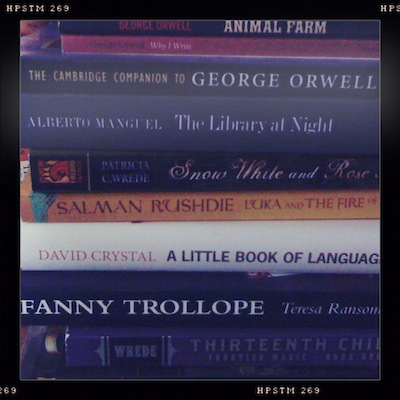Lifeline Bookfest 2012 (January)
Posted 17 January 2012 in Books by Catriona
Oh, Lifeline Bookfest. How I look forward to you every year. Well, twice a year, actually. And yet … and yet.
This year, I found the January sales just a wee bit disappointing. I suspect a big part of that was sheer exhaustion: my first full week (which isn’t a full week, for me) back at work after the Christmas season and seasonal chest infection, and I woke up with a splitting headache. So I wasn’t in a truly pro-Bookfest state of mind.
They’d also made what was, to me, a fairly significant change in the structure. The Bookfest has three sections: high quality, priced, and unpriced. Often, the unpriced section is fascinating: I have, in the past, found fabulous girls’ boarding-school stories there, because they’re not usually the types of the books that attract a high price tag. But the books in that section are also usually a bit grubby and often in poor condition. So, in recent years, I’ve stuck to the priced section while Nick winnows his way through the high-quality section.
And, as a cursory glance through my past posts will show, I tend to focus my attention on the children’s books, and then have a quick run through literature and paperback fiction.
(I only look at sci-fi and fantasy if I fancy being elbowed repeatedly.)
But this year, they’d stripped all the children’s books out of the priced section: they were only stacked in the high-quality and unpriced sections.
I should, of course, have gone straight to the high-quality section once I realised that, but I spent some dispiriting time in the unpriced section before I realised I really wasn’t going to find anything I could be bothered queuing up for. Then I went through the high-quality section.
As a result, I bought much less than I usually would.
I also resisted the urge to buy no fewer than three different versions of the Robin Hood stories, because they were all annoying in different ways. (Especially Roger Lancelyn Green’s version, in which Marian explained to her father that, yes, she considered herself promised to Robin and she was planning on going to live with him in Sherwood if her father continued to be a prat, but that she intended to remain Maid Marian until Robin’s lands and title were restored, which led me to assume that Marian was marrying Robin for the money and prestige. I don’t want to think that of Marian!)
As usual, the books are all children’s and young-adult fantasy, not least because I was exhausted by this point and couldn’t be bothered looking at the literature tables:

I really must get around to actually reading those Carole Wilkinson books at some point: I own three now (fortuitously, they’re the first three in the series, which is better luck than I usually manage), so I really do’t have any further excuse.
I’m also quite pleased about that Margaret Mahy: I’ll happily read pretty much anything by Mahy, and this one (“In a time not far from our own, a colourful group of travellers brave the twisting, tricksy landscape of the Remaking, after Chaos ripped the world apart. They are the magicians, clowns, trapeze artists and musicians of Maddigan’s Fantasia, healing the injured land with their gifts of wonder and laughter”) sounds delightful.
I’m also rather ashamed that I didn’t know it was based on a television series (whose concept Mahy developed), especially since spec-fic film and television is actually the focus of my current research.
Bad, bad researcher.

I have a sneaking memory, somewhere in the back of my head, that tells me I’d come across the Patrick Rothfuss somewhere before (an online review, or Amazon entry, or some such) and decided it didn’t appeal to me. But that vague memory only surfaced after I’d read the back, decided it did appeal to me, and bought it. I’m stuck with deciding for myself now, I suppose.
Still, to balance that, there’s always the Ursula Le Guin at the bottom, about a world in which reading, writing, and scholarship are punishable by death. Let’s face it: you can’t really go wrong with Ursula Le Guin.











































